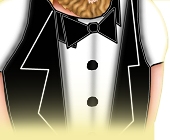


Barry Manilow Special
March 1, 1977
(special thanks to my Maniloonie friend for these reviews)
New
York Times
By
John J. O'Connor
TV:
ABC Prime-Time Specials
Blend
of Music and Variety Is Scheduled Tomorrow, Including an Hour With Barry Manilow
Tomorrow
night ABC is offering another of its prime-time lineups devoted exclusively to
music-variety specials. At 8, Dorothy Hamill, the figure skater, will glide about
with the Carpenters, Beau Bridges and Edward Villella of the New York City Ballet.
John Denver will come on at 9, thanking God that he's a country boy, with a little
help from Glen Campbel, Roger Miller and Mary Kay Place of "Mary Hartman,
Mary Hartman." Both Miss Hamill and Mr. Denver are veterans of the ABC specials
scene. For the 10 o'clock slot, however, the network has snared someone new: Barry
Manilow.
Mr.
Manilow is a very successful singer and composer and arranger. He initially came
to some prominence several years ago, as musical conductor and arranger for Bette
Midler. Deciding to start a performing career of his own, he was quickly skipping
down the golden road of hit records with such songs as "Mandy." He has
become a top attraction on the personal-appearance circuit.
And on top of
everything else he has written several of the most catchy tunes created for television
and radio commercials.
For his first ABC special, Mr. Manilow begins with a black-and-white vignette of a small boy being taken by his grandfather to a voice-recording booth on New York's 42nd Street. The show is dedicated to the performer's grandfather. The rest is mostly music, recorded at a concert outside Chicago and in a giant studio stage at Burbank, Calif.
With his regular backup group, three women called Lady Flash, Mr. Manilow sings his superhits ("It's A Miracle," "This One's for You," "I Write the Songs," "Mandy") and some lesser-known compositions ("Sandra" and "Early Morning Stranger").
He is joined by Penny Marshall of "Lavern and Shirley" for some innocuous comedy routines. He even throws in a "very strange medley" of his commercial ditties: plugging the wares of Kentucky Fried Chicken, Dr. Pepper, Pepsi-Cola ("Join the Pepsi People") and McDonald's ("You Deserve a Break Today").
The basic Manilow style might be described as slightly left of middle of the road. He is not a trailblazer. He has a facility for composing disarmingly simple melodies, in a manner of Neil Diamond or, perhaps, John Denver. These are then dressed up cleverly in slickly attractive arrangements. Add a pleasantly boyish singing voice, and the mixture is not terribly exciting, but soothingly pleasant.
As a performer, however, hounded by merciless camera closeups, Mr. Manilow may present some viewers with a bit of a problem. Despite all the standard show-business trappings, he remains a basically homely person with an unfortunate tendency to convey the impression that he is not very happy. His lighthearted moments seem forced. His gestures are stilted and awkward, curiously out of synch with his words. The overall effect is one of almost painful vulnerability. This same quality would be of inestimable value to an actor, but for a pop singer in front of squealing fans, it becomes a disturbing source of uneasiness. Mr. Manilow winds up in the strange position of being easy to listen to, difficult to watch.
Barry
Manilow Special
ABC, March 2, 10-11 p.m.
Hollywood Reporter(?)
Morna
Murphy
Singer-composer Barry Manilow turns out to be an unprepossessing charmer in his first TV special. He starts out strutting and warbling in the conventional concert setting looking like a lanky Walter Mitty living out one of his fantasies. Then it's a trip back in time to his early childhood, with a doting grandfather encouraging a shy little boy to sing. These scenes are wonderfully illustrated by the use of film footage and old photos.
Then we visit a lonely piano bar in New Jersey, where the young songwriting Manilow is working. Penny Marshall turns up as a cocktail waitress and shares with Manilow a poignant scene that illustrates the emptiness of a life without dreams. To round out the hour, Manilow sings a cheerful medley of familiar commercials he either wrote, produced or sang; he visits a New York tenement to sing a series of touching portraits; he sings and dances to the "Jump, Shout, Boogie" with his Lady Flash trio and Marshall, and he ends w\in white tie and tails, performing the Grammy Song of the Year -- Bruce Johnston's "I Write the Songs" -- his latest hit.
Writers of this very appealing hour are Allan Thicke, Don Clark, Susan Clark, Ronny Pearlman, Bruce Vilanich [their spelling, not my typo] Manilow and director-producer Steve Binder; interesting settings are by art director Tom John; musical direction that captures the New York rhythms and colors is by Jerry Alters; associate producer is Garry Blye; executive producer is Miles Lourie for Kamikazi Music Prods.